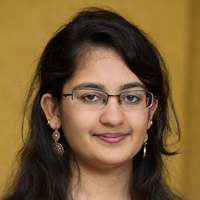Crisscrossing England to study medieval wood carvings
Christina E.C. Smith traveled to more than a dozen cathedrals in England to study medieval wood carvings depicting people, animals, hybrids and mythological creatures playing musical instruments, such as harps, fiddles and drums.
 To study medieval misericords, the narrow wooden ledges that monks leaned against while chanting psalms, Christina E.C. Smith needed a plane ticket to London, a BritRail Pass, her well-worn copy of A Catalogue of Misericords in Great Britain – and a really good flashlight.
To study medieval misericords, the narrow wooden ledges that monks leaned against while chanting psalms, Christina E.C. Smith needed a plane ticket to London, a BritRail Pass, her well-worn copy of A Catalogue of Misericords in Great Britain – and a really good flashlight.
Smith used the flashlight to illuminate the intricate images carved on the ledges, which are found on the underside of folding seats in choir-stalls in cathedrals, abbeys and small parish churches throughout England.
Village woodcarvers created the ledges to provide support for medieval monks, who were expected to stand during lengthy services. Informally, the ledges were known as "mercy seats," because they offered respite to monks weary from standing.
The study of the medieval world continually challenges and enriches my mind and heart – and musical sensibilities.
 The choir-stalls of Salisbury Cathedral house some of the earliest English misericords, dating to 13th century.
The choir-stalls of Salisbury Cathedral house some of the earliest English misericords, dating to 13th century.
Smith focused on English misericords of the 12th to 16th centuries with musical themes: carved images in which people, animals, hybrids and mythological creatures play musical instruments, such as harps, fiddles, drums, pipes and tabors.
Her research, which required crawling along cold stone floors, took her to more than a dozen ancient cathedrals, including Exeter and Winchester cathedrals in the south of England, Chichester Cathedral in the southeast, Ripon Cathedral and Beverley Minster in the north, and Durham Cathedral in the northeast.
"I received special permission to enter the famous Chapel of Henry VII in Westminster Abbey early one morning before tourists were allowed inside, so I could study its misericords," Smith said. "That was a rare treat."
Smith, who is now a junior, is majoring in classics and double minoring in archeology and medieval art history.
She said misericords depicting musical scenes remain the least studied within the entire corpus of medieval misericord images.
"This work strives to ignite such research; to not only draw particular attention to musical misericords themselves, but to begin to unravel their place in – and commentary upon – the complex, heavily debated arena of music in the medieval sacred realm," she wrote in her research paper, entitled "The Sentient, the Sounded, and the Silent: Artistic Expressions of Cor [heart] and Corda [vocal chord; instrument string] in the Carving of Late Medieval English Misericordiae Musicales."
Richard P. Martin, a professor of classics and one of Smith's faculty advisers on the project, praised her scholarly instincts.
"Christina has done what all real scholars must: immersed herself in the fine details of all the materials and developed a connoisseur's sense of the objects she studies," Martin said. "Her ambitious plan involved lots of footwork, as well as long days in the library. I'm delighted that she is so passionate about both."
Smith singled out several carvings for close examination, saying they illuminated the complicated and changing place of music, musicians and instruments of the era.
One carving that caught her academic and artistic eye at Exeter Cathedral depicts a mermaid and merman holding a drum or cymbal.
"Hovering gracefully over a sea of polished wood, the Exeter misericord's mermaid and merman appear as though just emerging from the ocean foam so as to perch their bodies on a rock," she wrote, adding that the creatures do not look at each other, but outward into the choir-stall.
"Thus the Exeter misericord invites the viewer-made-participant into this world of the carved and created, asking of him to partake of its charm and ambiguity," she wrote. "The outward-looking gazes of the mercreatures posit that the misericord is not an object merely to be viewed, but a carved world with which to necessarily interact."
At present, Smith hopes to become a Celticist, a scholar specializing in the peoples and linguistic traditions of early medieval Scotland. She said traditional Scottish fiddling – she is an accomplished performer – inspired her academic interests. At Stanford, she is a member of the Early Music Singers, which specializes in medieval, Renaissance and early Baroque vocal music.
"The study of the medieval world continually challenges and enriches my mind and heart – and musical sensibilities," she said.
Martin said it was clear that Smith was a "born scholar" when they met in his freshman seminar on medieval Irish literature.
"She has all the making of a fine researcher – curiosity, erudition, tenacity and good humor," Martin said. "The summer field research that Stanford's undergraduate research programs provide are a superb basis for her continuing growth."
View other projects

Snail fever
A dam that brought fresh water also brought disease, but an environmental solution might help

Brain research
A drug that helps mice learn more effectively, even later in life, holds promise for human disease

Gold-mining camps
Backpacking deep into the Alaskan wilderness, sisters study long-abandoned gold-mining camps

Hip-hop
Alston delved into an arts organization’s success, with the aim of helping other groups serving youths.

Rocketeers
Pushed the limits of amateur high-altitude exploration by launching a custom-made rocket from a balloon.

Mother monster
Monsters abound in medieval literature, and the same themes of female monstrosity carry on today

Medieval carvings
Visited English cathedrals to study misericords with musical themes, such as a boar playing a fiddle.









